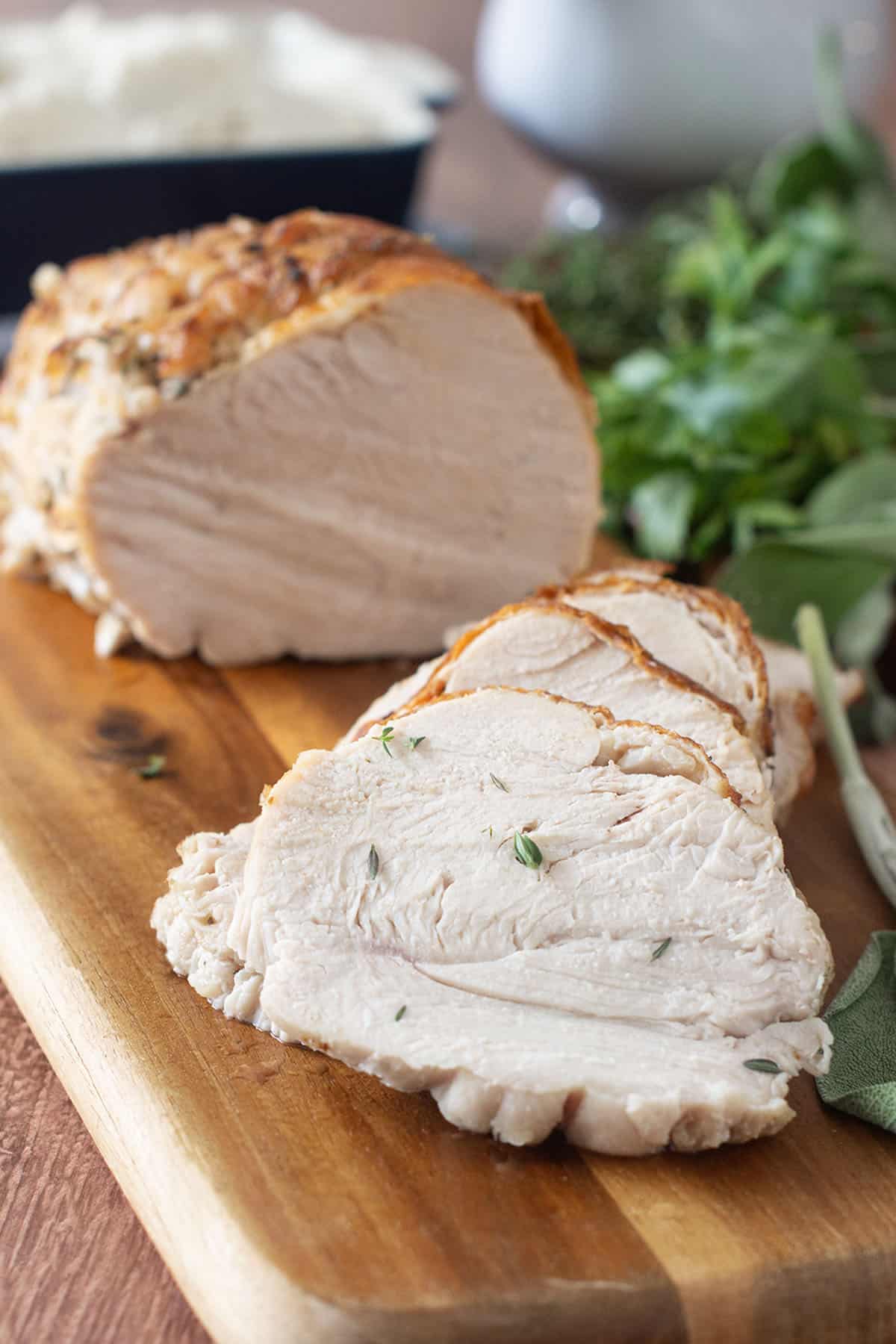With this Roasted Turkey Breast recipe, you can have delicious roast turkey in less time. Perfect for a smaller Thanksgiving meal or even a weeknight dinner!
Choosing a turkey breast over a whole turkey is a great option if you’re having a small-ish group for a holiday meal, or if you all prefer white meat over dark meat. And the boneless turkey breast is super-easy to cook and to carve, so it’s a great idea to make things easier.
Scroll down to read more about how it all comes together or click here to jump straight down to the recipe.
- Video: Cooking Boneless Turkey Breast
- What Kind Of Turkey To Get?
- Brining To Make a Juicy, Flavorful Turkey Breast
- Getting Crispy Skin That’s Nicely Browned
- Temperature For Turkey Breast
- Gravy For Turkey Breast
- Carving Boneless Turkey Breast
- Complete Your Turkey Dinner
- Podcast Episode About Making Boneless Turkey Breast
- Juicy Boneless Roasted Turkey Breast Recipe

Breast meat can be drier than dark meat, so I’ll be telling you about a couple of steps to make it extra-juicy and delicious. We’ll tackle that below, but it basically involves using a very flavorful brine for a short time (just 1 hour) and then adding butter to the outside of the turkey. And not overcooking it, of course, which we make sure of by recommending an inexpensive thermometer.
Video: Cooking Boneless Turkey Breast
What Kind Of Turkey To Get?
This recipe is for a boneless turkey breast which usually has skin on it. It’s available most of the year in regular grocery stores in the frozen meat section. Some months it’s available fresh (not frozen). If yours is frozen, it needs to be fully thawed before you proceed. This is different from Turkey Tenderloins which are smaller pieces that are boneless and skinless.
Thaw it by putting the whole thing, with its packaging, in a sink or pot full of cold water for about 2 hours. Every 30 minutes or so, check on it to see if it’s thawed and change the water. Once it’s thawed, refrigerate it until you’re ready to proceed with the instructions below.
These boneless turkey breasts often come with a plastic mesh outer packaging which you will remove once it’s thawed. Then also take off the plastic wrapper. But, if your turkey has a string mesh bag under that, keep that on there. That’s there to keep the turkey breast held together in one piece and you want that.
If your turkey also came with a packet of gravy, remove that from within the mesh bag. You can follow the instructions with your turkey breast to use that gravy pack, or make your own gravy following the instructions below. Note that you can add that packaged gravy to your homemade gravy, if you’d like. I’d taste both first and then decide if you want the addition or not.
Have another kind of turkey? Try my Whole Roast Turkey recipe or if you have a variety of turkey pieces, my Roasted Turkey in Parts recipe.
Brining To Make a Juicy, Flavorful Turkey Breast
I’ve gone back and forth about making this brining step optional. I completely understand why people don’t want to brine turkey. The reason is usually about how long it takes. But in this case, it only adds an hour to the total time. And it’s a hands-off hour where the turkey is in the fridge in a small container. Given the tendency for turkey breast to dry out and be bland, I highly recommend using a brine. That bit of extra seasoning right inside helps a lot, but it’s mostly about the moisture.
You can use a basic brine of 4 cups cool tap water with 4 tablespoons of Morton’s kosher salt. Once the salt is dissolved, the turkey breast goes in the solution for 1 hour. Keep it all refrigerated for this time.
One big step better than that basic brine though is this super-flavorful turkey brine recipe. It’s stellar on this, and it’s actually what I do every time I’m roasting a turkey breast. You basically pulverize a bunch of flavorful ingredients like raw onions, garlic, and fresh herbs in the blender. That extracts flavorful juices from them which then gets absorbed into the meat while brining. Here’s what you do:
- To a blender or food processor add 2 cups cool tap water, 4 tablespoons kosher salt, 1 raw onion (quartered), 5 cloves garlic (peeled), a big handful of fresh parsley (with stems), about 15 fresh sage leaves, and 10 sprigs of fresh thyme. Blend that all up. It will be chunky but everything will be in small pieces.
- Transfer your boneless turkey breast to a narrow container that just fits it (my blender is big enough that the turkey breast fits right in there!). Pour on the brine mixture. Add up to 2 cups more water to cover it fully. It needs to be completely submerged. Stir it around a bit. Refrigerate for 1 hour. Note that if the turkey isn’t submerged fully, you need to make more basic brine, which is just 1 cup water with 1 tablespoon kosher salt. Mix that up and add it so the turkey is covered.
Brining the turkey breast is optional. But I do think it makes a huge difference and I urge you to try it.
Getting Crispy Skin That’s Nicely Browned
A boneless turkey breast spends less time in the oven, by far, than a whole turkey or than a bone-in turkey breast. For this reason, getting that nice crispy skin can be a bit more challenging. But don’t worry, we’ve got this figured out. Here’s what to do.
Take the turkey breast out of the brine and pat it dry. If you use that herby brine, there might be some little bits still stuck to the outside, which is fine. Leave them there. Rub the outside of the turkey all over with 3 tablespoons of softened unsalted butter (don’t add anything with salt to the brined turkey).
Then, put the turkey breast skin-side-up on an oven-safe rack set over a baking dish. By roasting the turkey on a rack, the air can circulate all around it to help brown it everywhere. And the butter is going to help it brown as well and give lots of great flavor.
Preheat the oven to 450°F. Let the turkey just be on the counter for this bit of time as the oven preheats. Having it closer to room temperature before roasting will help it cook more evenly. Then put it into the oven and roast it for 30 minutes.
Reduce the heat to 300°F at this time and continue to cook until the internal temperature is 160°F. If the skin starts to get too dark in this time, which is unlikely but can happen, tent the turkey loosely with foil.
Once the turkey comes out of the oven, let it rest for at least 10 minutes. Make sure that in that time the turkey comes up to the safe temperature for turkey, which is 165°F.
Then, if the turkey has an oven-safe string net on it, this is when you remove it. I find it best to snip it off with kitchen shears first, and then carefully remove it with my fingers. It can sometimes stick to the meat/skin and pull those crispy bits away, so just remove it carefully. You spent all that time getting a nice crispy skin so you don’t want it to all come off!
Temperature For Turkey Breast
The safe temperature for turkey breast is 165°F. You can take your turkey breast out of the oven at 160°F and after a 10 minute rest, it should have raised up to 165°F. It’s best to double-check this using a thermometer.
I find a probe thermometer with a digital reader kept outside of the oven is the easiest thing to use. You can also use an instant-read meat thermometer. The difference is that for the instant-read, you need to open the oven and possibly take the turkey out to test the temperature. This isn’t necessary with the probe.
And truly, the probe is best whenever you don’t want to risk overcooking something, which we don’t want to risk with turkey breast. With the probe, you have the digital reading outside of the oven to look at and monitor. So you know exactly when to take the turkey out of the oven to make sure that it doesn’t overcook and dry out.
Gravy For Turkey Breast
It’s unlikely that a lot of juices (drippings) will come from your turkey breast because it’s so lean. But you can still have amazing gravy!
Remember, if you did the brining and the buttering of the turkey, then any juices that do come out are going to be pretty tasty! To make sure that you capture all of them and that they don’t burn in the bottom of your roasting pan, try this:
- Before the turkey goes into the oven, pour about 1/4 of an inch of water or unsalted chicken stock into the bottom of the pan. The drippings will fall into there and will not burn. Instead, as the liquid evaporates, they will intensify and also caramelize a little bit to the sides of the pan.
- When you check on the turkey in the oven, if you notice the amount of liquid has gone down, top it up. That also allows the caramelization of any juices accumulating up the sides of the pan to get dissolved into your drippings.
Then you will use those drippings to make gravy however you like to make it, or use my delicious gravy recipe. Alternatively, you can use this recipe for making gravy without drippings (which is a make-ahead recipe!) and then add in any drippings you get from roasting and carving your turkey to the gravy at the end just before serving for extra flavor.
Carving Boneless Turkey Breast
The nice thing about this boneless turkey breast recipe is that it’s really easy to carve. You simply slice it from one narrow end to the other. I just have three things to note on this topic:
- I already said this, but make sure to let the turkey breast rest for 10 minutes after cooking. That resettles the juices so they don’t just come pouring out when you slice in. It also gives the turkey time to come up to the required 165°F.
- Use a sharp knife when slicing the turkey so that the knife goes through the skin and you get nice crispy skin on each slice. Note though that sometimes even sharp knives don’t want to go through the crispy skin just right. If you’re having trouble getting thin slices of skin on each slice, try using the tip of your knife to make a slit in the skin first. Once that slit is there, you can put your knife blade in there and slice down.
- Be sure to use a rimmed cutting board when slicing the roasted turkey breast. That way, any juices that come out of the turkey won’t end up on your counter, but also, you should add those juices to your gravy. If you’re not making gravy, you can sprinkle the juices back over the turkey slices after you’re done carving. Those are some nice turkey juices there so put them to good use!
Complete Your Turkey Dinner
You’ve got the turkey and the gravy covered, now pick a couple sides from this list to round out your meal. Enjoy!
- The Best Stuffing Recipe (not cooked in the turkey, so it’s perfect for with the turkey breast!)
- Green Bean Casserole
- Roasted Potatoes Recipe
- Sweet Potato Casserole
- Cranberry Relish
- Homemade Cranberry Sauce
Podcast Episode About Making Boneless Turkey Breast
Listen to me explain briefly about how to make this turkey, along with some other great tips, by clicking the play button below:
Listen to more Recipe of the Day episodes here.

Juicy Boneless Roasted Turkey Breast Recipe
- Prep Time: 1 hour 10 minutes
- Cook Time: 1 hour 15 minutes
- Total Time: 2 hours 25 minutes
- Yield: 4 servings 1x
- Category: Entrée
- Method: Roast
- Cuisine: American
DESCRIPTION
With this Roasted Turkey Breast recipe, you can have delicious roast turkey in less time. Perfect for a smaller Thanksgiving meal or even a weeknight dinner!
Ingredients
- 4 cups cold tap water, divided
- 4 Tbsp. Morton’s kosher salt
- 1 onion, quartered
- 5 cloves garlic, peeled
- 1/2 cup fresh parsley
- 1/4 cup fresh sage leaves
- 1/4 cup fresh thyme sprigs
- 3 lb. boneless turkey breast roast
- 3 Tbsp. softened butter
- 2 to 3 cups unsalted chicken stock (optional)*
Instructions
- To a blender or food processor add 2 cups of the water, the salt, onion, garlic, parsley, sage, and thyme. Process until it’s all in tiny little pieces.
- Put the turkey breast in a container or pot that just fits it (narrower is best – it might even fit right into your blender). Add the water mixture. Then, add up to 2 cups more water so that the turkey is fully submerged. Refrigerate for 1 hour.
- Remove turkey in liquid from refrigerator. Remove turkey from liquid and pat it dry, but it’s fine if some little bits are still attached. Discard the liquid.
- Rub the turkey all over with the butter. Place it onto an oven-safe rack set over a roasting pan or baking dish. Pour enough chicken stock into the bottom of the baking dish so that it comes up about 1/4 of an inch.
- Preheat oven to 450°F, allowing the turkey to be at room temperature while the oven preheats.
- Transfer the turkey, rack, and baking dish to the oven and roast at 450°F for 30 minutes.
- Reduce temperature to 300°F. Continue to bake the turkey until the internal temperature is 160°F, about 45-60 minutes more. If the amount of chicken stock in the baking dish has reduced, add a bit more.
- Transfer turkey to a rimmed cutting board and let it rest for at least 10 minutes. During this time, you can use the stock to make gravy.
- Double check that the internal temperature of the turkey has reached 165°F. Then slice the turkey and serve.
Notes

























Can this turkey be made in a crockpot? If so, could you give me the instructions and ingredients to cook it in a crockpot? Thank you so much!
Antoinette, I haven’t tried it with the brine, but I have done it in the slow cooker before. What I did was to mix up this turkey butter https://cookthestory.com/compound-butter-for-turkey/ and while it was still soft, rubbed it all over the turkey breast. Pour 1 cup of chicken stock into the slow cooker. Then put some whole veggies like celery and carrots in there and put your turkey breast roast on top. Those veggies are really just there to elevate the turkey from the bottom. Cook on low for 5-6 hours, until internal temperature in middle of turkey breast is 165F. Take turkey out of slow cooker and let it rest for 20 minutes uncovered. Then, if desired, crisp the skin by putting the turkey skin-side-up under the broiler, so that the skin is about 6 inches from the heating element. Check it every minute until it’s crispy. Note that the liquid left in the crock pot can be used to make gravy following these instructions https://cookthestory.com/chicken-gravy/ Let me know if you give it a try!
It will just be my husband and me this Thanksgiving so I made this as a “trial run”. It was fantastic. Happy to have a great recipe for a smaller portion.
It will just be my husband and me this Thanksgiving. I’m definitely going to give this a try. Happy to have a great recipe for a smaller portion so I don’t have to cook a whole turkey!
This turned out so flavorful. We can’t believe how much the brine flavors got into the meat. And the skin was crispy. Loved it!